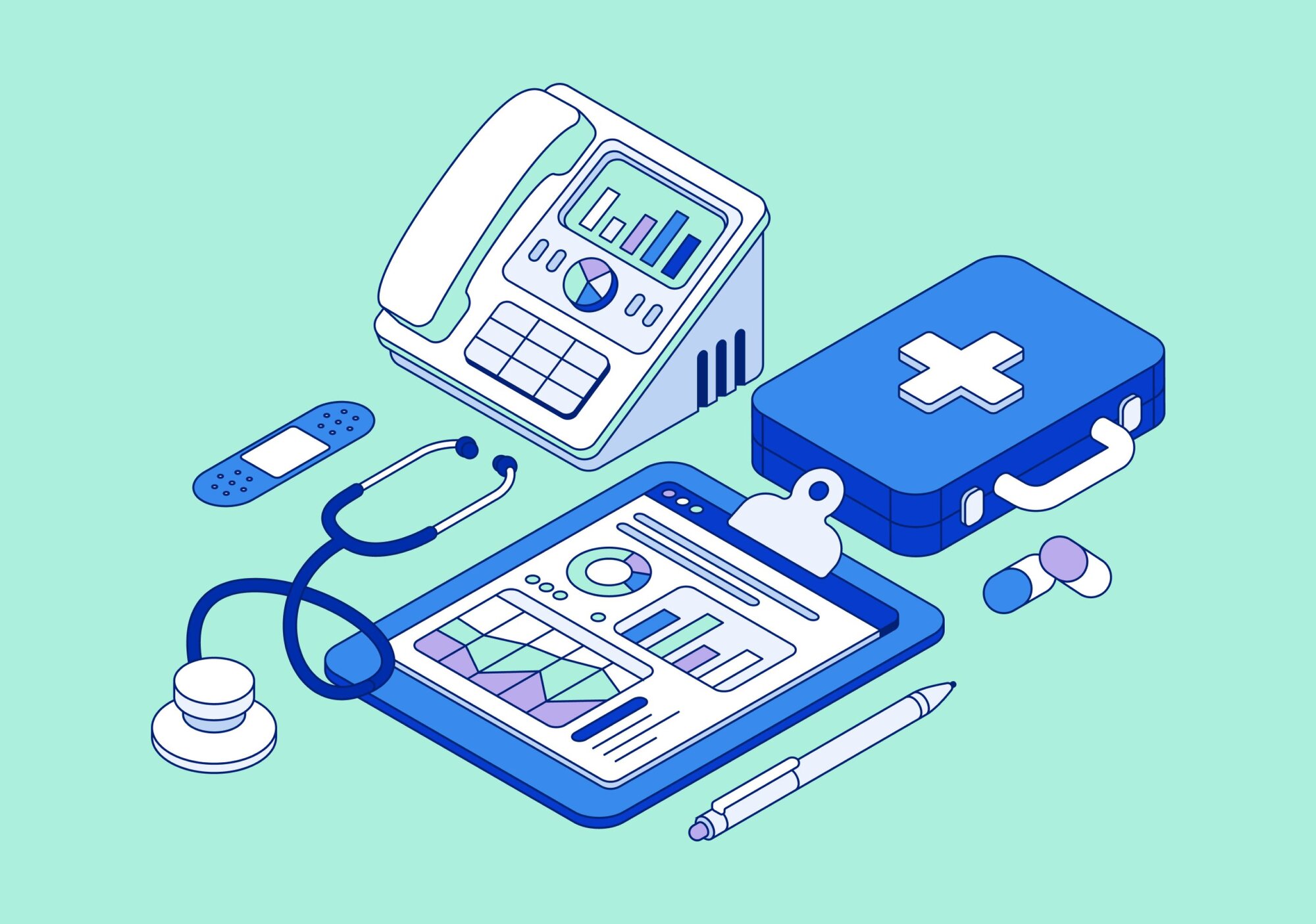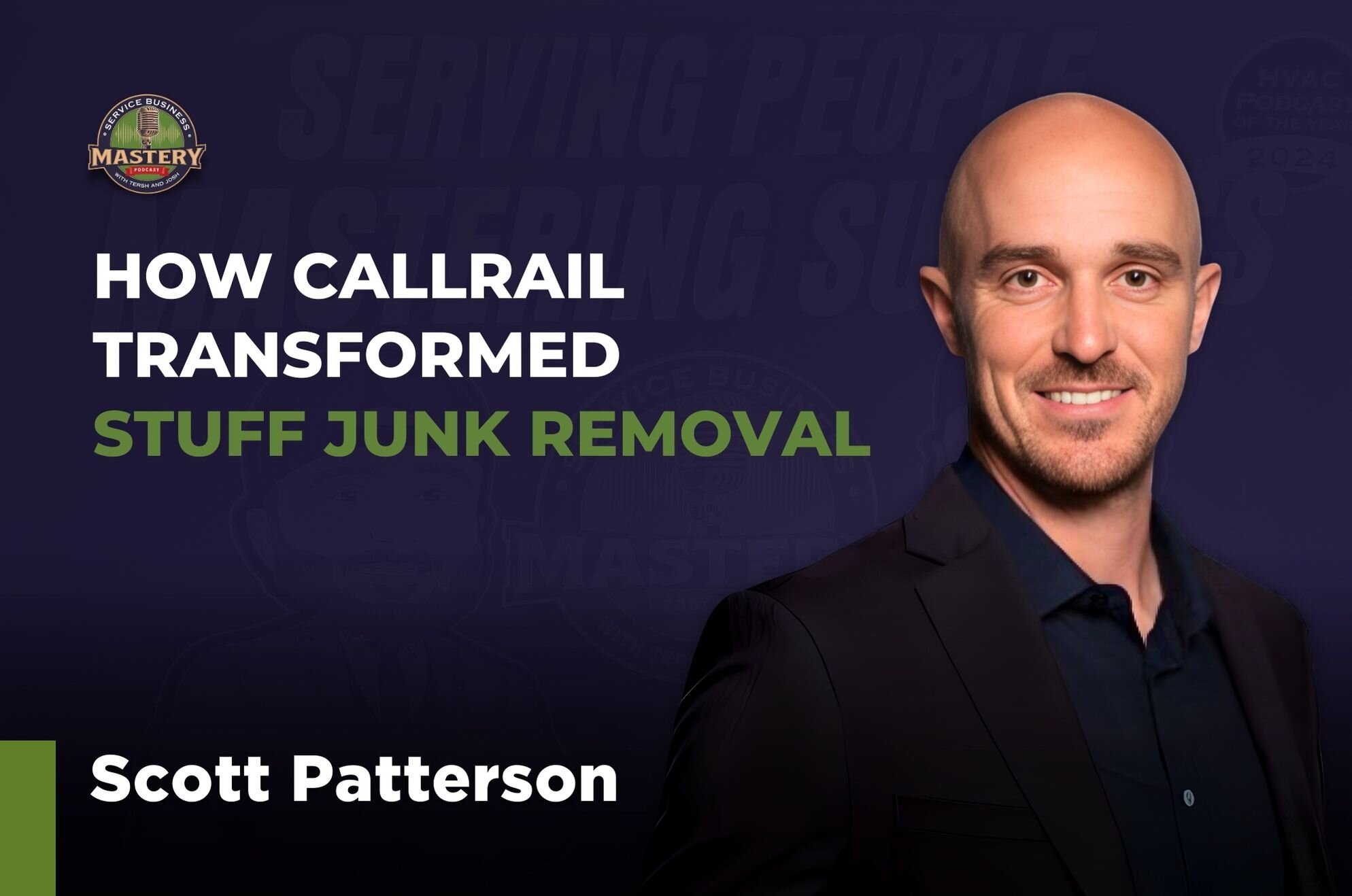Today, healthcare providers must not only have online visibility but also be able to build patient trust to win business. At the same time, they have to manage HIPAA compliance, potential insurance challenges, and provide a highly patient-centric experience.
So, how is healthcare marketing evolving and continually growing business while meeting consumer expectations?
To get a pulse on 2024 healthcare marketing trends, CallRail surveyed almost three dozen healthcare providers. We also spoke with Eric Hubbard, Founder of Pain-Free Dental Marketing, an agency that specializes in digital marketing for over 100 dental practices, and Andrew Miller, Co-founder of Workshop Digital and VP of Client Services, a digital marketing agency working with many clients in the healthcare agency
Here are the top marketing trends we uncovered.
Trend #1: Digital channels will dominate healthcare marketing in 2024
When asked what tactics they planned to deploy in 2024 to reach more new patients, website and SEO (79%), social media (64%), and email marketing (54%) were the top three marketing tactics chosen. Non-digital tactics like events (43%) and print marketing (32%) ranked last.
What tactics do you plan to deploy in 2024 to reach more leads?
In a clear indication of the importance of digital channels for healthcare marketing, most healthcare marketers are also prioritizing digital channels in their 2024 marketing budget. Website and SEO initiatives were given the highest priority, with social media and email marketing coming in second and third, respectively.
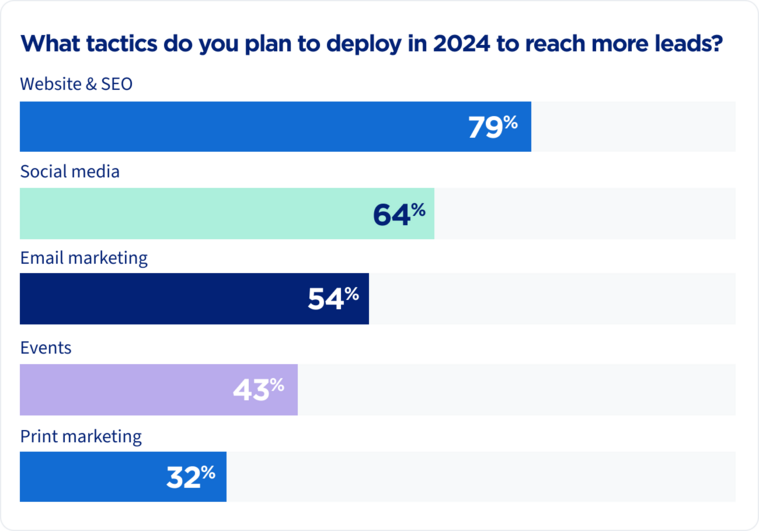
In order of priority, where do you plan to spend your 2024 marketing budget?
One challenge with pivoting to more digital marketing strategies is that HIPAA regulations and the use of electronic health record (EHR) platforms limit access to customer data.
"With a lot of our healthcare clients, we're approximating the value of a phone call based on what an average patient is worth, but we can't go into their systems and say this click led to this much revenue or ROI," says Miller. "A simple way to approximate ROI is to look at total phone call volume, calculate how many of those are new vs. existing patients, and multiply by the average value of a new patient."
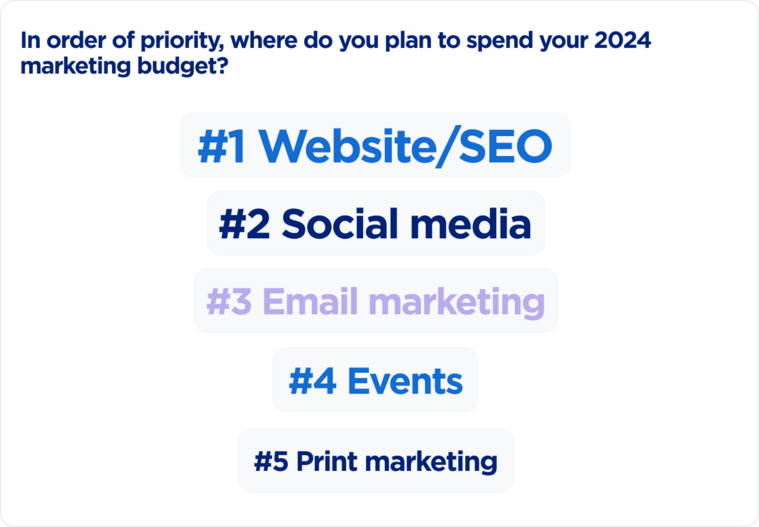
Trend #2: The use of AI and online scheduling technologies will increase
Beyond adopting more digital marketing channels, healthcare providers are also leaning into technology in other ways to enhance both marketing and the patient experience. In our survey, healthcare providers indicated that they planned to use AI to solve problems like:
What problems do you plan to use AI to solve?
Overall, Miller notes that Workshop Digital is "very bullish on AI and ChatGPT," especially for automating and streamlining day-to-day work. But Miller acknowledges that healthcare practices and those who work in the industry need to take extra caution.
"We’re pretty guarded,” says Miller, noting that they can’t upload sensitive data to ChatGPT, even if the data is anonymized or scrubbed. “It’s just too risky right now because we don’t know what the AI tools are doing with that data.”
Scheduling appointments (25%) also stands as a significant use case for AI, and Hubbard believes that online scheduling will take on a new focus in 2024.
“We're going to see the rise of and continued push for online scheduling. Specifically, we’ll see the large organizations moving toward it,” says Hubbard, “and they’re going to put pressure on the smaller single operators to roll out online scheduling. So, I think we're going to see sort of a paradigm shift.”
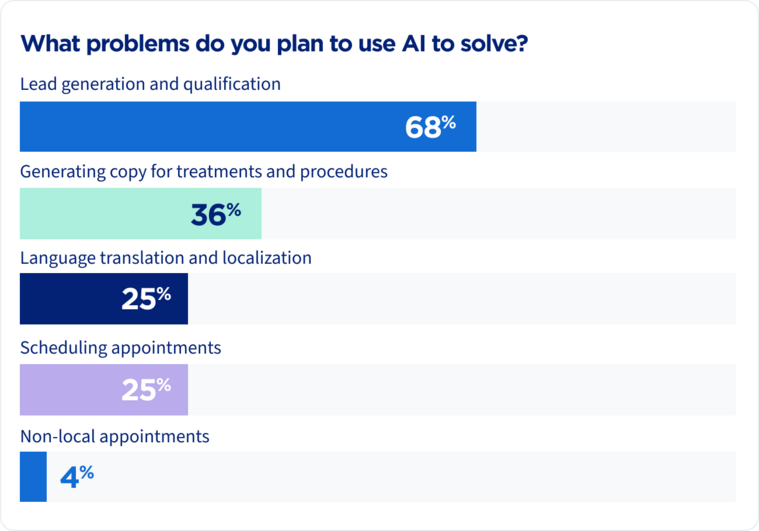
Trend #3: The phone will remain the primary channel for leads in 2024
While healthcare marketers are shifting to more digital channels for lead generation, the phone is still the primary channel leads use to get in touch with them. It is also the easiest way for most healthcare providers to communicate with leads and patients.
“Most dental practices do not have the technical capability nor the team to roll out something that isn’t phone-centric,” notes Hubbard. “Take live chat – most offices are terrible at answering chats. They'll go days without responding, and patients move on, so they've pulled chats off their websites. They can easily answer the phone because it's right there, and that tends to be, from an office standpoint, the path of least resistance. Everyone's trained to know how to do that.”
Given that phone calls will remain a dominant channel for communicating with leads in 2024, healthcare providers need to become savvier in using them for lead generation. For example, through technologies like Call Tracking, healthcare marketers can gain insight into which marketing campaigns and lead sources are bringing in patients – and which aren’t. This helps them to spend their marketing dollars more wisely on the most successful channels.
Trend #4: Economic headwinds will be the biggest challenge
When asked about what unique challenges might impact business in 2024, healthcare providers overwhelmingly indicated that the economy would continue to have the biggest impact. Competition/crowded marketplace came in second, and maintaining HIPAA compliance was the third biggest challenge for 2024.
What unique challenges might impact your business in 2024?
Hubbard concurs that the inflationary economy is having an impact on healthcare providers. “There's uncertainty around the economy,” he notes, stating that while healthcare and dentistry have always been fairly recession-proof, and he still thinks that will be the case, he does expect some slowdown, specifically with cosmetic procedures.
“Consumers are also going to make better decisions and have less risk tolerance,” says Hubbard. “So, I think that case studies, demonstration of excellence, and social validation are going to be much more important moving into 2024 than they are today.”
For Miller, the biggest challenge they’re seeing is around HIPAA compliance. “There are many cases where clients aren’t even aware of some of the changes that have happened in the HIPAA space, including the new guidance coming out from the government and some of the lawsuits going on that are challenging us as marketers,” says Miller.
He also notes that part of the trend is greater data privacy, which makes it harder for marketers to do their jobs. “We can’t target as efficiently as we used to be able to,” says Miller. “We’ve got to figure out how to work within all the constraints we have, so we’ve just got to be smarter and stay a step ahead.”
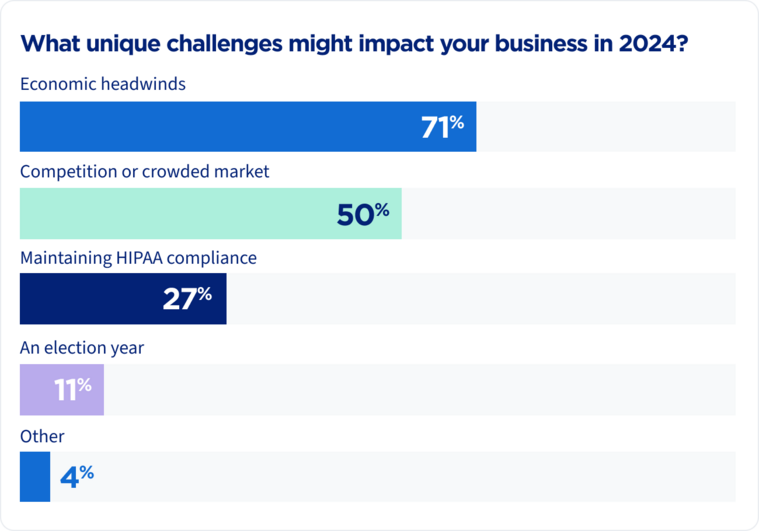
Trend #5: 2024 will be the year of showcasing value and building trust
Healthcare providers will also need to focus on building trust and highlighting their value in 2024. This will be especially true for dental practices, where a growing number are dropping insurance plans due to falling reimbursement rates. As a result, when leads call in, practices must shift how they answer the phone.
Hubbard notes that offering a differentiated experience is especially important when healthcare practices no longer take insurance because they must shift from an order taker into a sales role.
“You need to be telling the patient why this doctor is amazing and explain why they may or may not be the best fit for you,” says Hubbard. “And that cultural shift of how the phone is answered as we move to more fee-for-service or less insurance-driven practices is going to be fairly dramatic, especially in an inflationary economy. It's going to change from, ‘I'm looking for anyone who needs a dentist’ to ‘I'm looking for people who value me and my service.’”
Miller agrees that in the coming year, it’ll be more important for healthcare practices to differentiate themselves. “Everybody can talk about symptoms and treatments all day long,” says Miller, “but making it easy to contact you and making it feel like that person will be welcome in that practice – that's the stuff that'll differentiate a practice and get somebody to pick up the phone and actually call.”
Make 2024 a year of transformation
Healthcare marketing is often seen as behind the times. However, given the economic challenges ahead and the need to increasingly show value and build trust with patients, the healthcare industry must embrace greater marketing innovation and use of technology.
Using AI-powered tools to help with lead generation and improve the patient experience is a key area of focus, as is doing more to provide self-service technologies like online scheduling. But perhaps one of the most important keys will be continuing to mine phone call data and keywords for insights into what patients are saying they want most and what concerns they have that you can speak to in your marketing campaigns. The better you can understand your prospective patients – the more strategically and effectively you can market to them.
Start your 2024 off with more insights about who’s calling your healthcare practice with CallRail’s marketing and communications platform.



